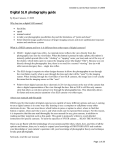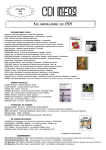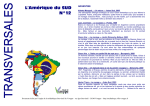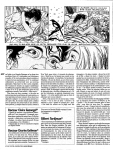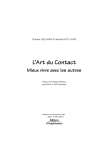Download Jan, 2013 - Flushing Camera Club
Transcript
The Info Sheet FLUSHING CAMERA CLUB … in our 42nd year and counting. Member: Photographic Federation of Long Island (PFLI) “Together in friendship may we learn the art of photography” Volume 15 Number 5 FCC Executive Committee Officers: President: Mary O’Connor, 718. 939.4963 Vice President: Ramiro Agredo, 718.664.7366 Treasurer: Joe Caruso, 718.357.4251 Secretary: Tony Coppeta 718- Committee Chairpersons: Administration: Frank Reynolds, 718.263.9131 Compettion: Stan Strauss, 718.423.2825 Programs/Education: Helen Repstad, 718.845-4477 Field Trips: Joe Crupi, 718.343.0280; Michael Sender, 718.459.0203 Membership: Tom Mrwik, 718-343-8387 Publicity: Adam Holstein, 718.463.5538 PFLI Delegate: Helen Repstad, 718.845.4477 The Info Sheet: Joe Crupi718-343-0280 Ron Caldwell 917-806-6170 Website: Ramiro Agredo, 718.664.7366 Additional Board Members: Marty Fleischer: 718.591.8246 Dennis Golin: 718.479.0643 Ron Caldwell Dorothy Gist Web Site: January 2013 FROM THE EDITOR’S DESK: Wishing our members a fabulous 2013 full of great experiences, achievements and the opportunity to capture the images you always envisioned. There are meaningful pages in your book of life waiting to be written in 2013. HAVE A GREAT & HEALTHY NEW YEAR! . Joe Crupi . 2nd - competition #5 - Judge (change) Ken Bausert 16th - 7:15 “Exposure Time” Ettore Trauzzi ………...7:30 Program t.b.a. (due to cancellation) 30th - 7:15 “Show & Tell” Adam Holstein …………7:30 Creative Critique www.flushingcameraclub.org Meetings: 7:30 pm, 1st, 3rd, 5th Wednesdays at Flushing Hospital, Auditorium, 45 Ave & Parsons Blvd., Flushing. Park on street or in lot across 6th - competition #6 - Judge t.b.a. the street from Hospital. Parking ticket MUST be 20th- 7:30 Macro Photography Harvey Augenbaum validated by the Camera Club. Dues: $40.00 for individual $60.00 for family;$20.00 for WEATHER ALERT! If a meeting is cancelled due to snow or ice conditions, an students: up to 23 yrs. email will be sent to all members on the day of the meeting. If members have any questions about possible cancellations, call Mary O’Connor at 718-939-4963. January 2013 Page 2 SPOTLIGHT ON Bernie Gellman When I was in the Army in Southeast Asia, I bought my first camera a Minolta but I now use a Pentax K5, with Tamron and Pentax lens. My Tamron 18-250 mm is my all-around lens. I use Photoshop to process the raw files. I joined the Flushing camera club in Feb. of 2011, wanting to expand my photo hobby since I was now retired from NY City service (Supervisor in the Electric shop NYCFD). After an “on line search” I found the Flushing Camera Club. I enjoy shooting sunrise, sunsets and bugs, my favorite picture is one with a butterfly and bee on a cone plant that I shot at work during my lunch ½ hour when I was working at the US Merchant Marine Academy. I like to learn new ways to take and process pictures on my computer. Bernie Gellman Restricted CompeƟƟon for May 2013 is “Aged.”..old, aging, rusty, showing corrosion, wilting, structures in disrepair, flowers past their peak, a portrait of the elderly etc. Helen Repstad is recuperating from a recent hospital visit. We extend our best wishes for a full recovery. A Bob Green Photo Tip According to topaz labs, others... 5 things that one should never ever sharpen: [computer digital editors] 1. the sky, especially blue sky 2. constant color areas 3. out of focus areas in one's photo 4. flowing water 5. human skin, especially of a female why? Because you may introduce grain or noise to your photo unnecessarily. —unless that is the result you want. Photography Links & Resources Flushing Camera Club: www.flushingcameraclub.org PFLI: www.pflionline.com PSA: www.psa-photo.org Stan Strauss: http://www.stannich.com Ron Caldwell: http://www.fotosbyron.com www.photoplugins.com Hunt’s Photo: Gary Farber, [email protected] Russ Burden: www.russburdenphotography.com www.takegreatpictures.com Online Display and Review: www.flickr.com Digital Photography Review: www.dpreview.com Canon Camera: ww.usa.canon.com . Nikon Camera: www.nikonusa.com Adobe Photoshop: www..adobe.com Natl. Assoc. Photoshop Professionals: www.photoshopuser.com B&H: www.bhphoto.com January 2013 page 3 Tony Coppeta Lucy Pearce Bridge Flag Nelly Moser Digital B Bob Green Eugene Kolomatsky Duck B&W S Digital A Eugene Kolomatsky Two Sons Color A Joe Crupi Old Waits River Digital S Ramiro Agredo Talking to Me Horse Snout B&W A Color S January 2013 page 4 Standings After November Competition: DIGITAL A COLOR S 1 Helen Repstad 8 19 1 1 Ramiro Agredo 8 23 2 Lucy Pearce 8 18 3 2 Bob Green 8 15 3 Henry Szczepanski 6 12 3 Ann Grodman 8 12 2 3 1 Suzanne Abruzzo 8 15 1 1 TIE 4 Roy Woelfel 8 8 TIE 4 John Baratta 6 8 6 Stan Strauss 4 4 4 B&W-B John Baratta DIGITAL S TIE 1 Ramiro Agredo 7 19 2 B&W-A TIE 1 Joe Crupi 8 19 2 3 Tom Mrwik 8 15 2 Gene Kolomatsky 3 6 3 Marty Neff 2 0 TIE 4 Michael Sender 8 14 TIE 4 Bob Green 8 14 6 Ann Grodman 8 12 B&W-S 7 Joan Egan 8 10 1 Ramiro Agredo 8 23 3 8 Barbara Shea 4 8 2 Bob Green 8 14 1 9 Martin Fleischer 8 7 3 Ann Grodman 8 8 2 6 10 Russ Burden Compiled by Helen Repstad January 2013 page 5 Long Lens Techniques By Russ Burden A number of the nature photography tours I run are to places where long lenses are the lens de jour. The animals are either far away, small, or a combination of both. These types of situations call for a long lens to get frame filling images. A long telephoto’s primary claim to fame is to bring distant subjects closer or to make small subjects appear larger in the frame. But these lenses have other huge advantages that often go unnoticed or unrealized. Long lenses do not focus close. As a matter of fact, their near focus minimum is often measured in yards as opposed to feet or inches. To counter this, add an extension tube so the lens can focus closer. Small subjects that allow you to get close will appear bigger in the viewfinder so you’ll use more pixels to your advantage. It also helps offset the subject from the background. This is a great segue to discuss another advantage of a super telephoto. The narrow angle of view with the extreme magnification results in a very narrow depth of field. Backgrounds become a wash of color and distractions are minimized. The subject stands out . Another benefit is they provide a look that compresses subject layers. In other words, background and foreground objects are perceived to appear closer together as if they are stacked. Used in the right way, it provides a great effect. Use a Gimbal Head and Sturdy Tripod: A long lens not only magnifies the subject, it also magnifies your mistakes. The most evident mistake comes in the form of lens/camera movement. The result is soft images, especially as the shutter speed is slowed down. To prevent lens/camera movement, use a STURDY tripod. I intentionally capitalized the word sturdy. Think bigger, bolder, stronger. Put your extreme telephoto on a tripod that deserves its placement. Give it the “flick test.” With the lens on your tripod, give the legs a good flick with your finger. Do this a couple of times. If you see any movement whatsoever, the tripod is NOT sturdy enough. I have a separate tripod dedicated to my long lens. It’s heavier, longer, sturdier and more expensive than my standard one. When my long lens goes out of the house, in my other hand is the dedicated tripod. Mounted to its top is a Wimberly gimbal head. There are a number of manufacturers who have jumped on the gimbal bandwagon. Be sure to acquire one as the fluidity with which they work will make you happy you did. Fast shutter speeds help offset blurry photos that come as a result of lens/camera movement. The rule of thumb is to use a shutter speed that’s the reciprocal of the focal length. If you use a 500mm lens, use 1/500th of a second to get a sharp photo. If the lens is mounted to a sturdy tripod, the shutter speed can be reduced. But don’t get caught up thinking that you can use a slower shutter speed for all conditions. You’re at the mercy of the animal’s movement. If the subject moves and the shutter is slow, the animal will not be sharp. The focal length to shutter speed reciprocal is more used for hand holding but hand holding these long lenses can be a problem regarding a fine tuned composition. If the subject fills the frame and you don’t have Mr. Universe arms, good luck with the composition. Finally, there’s the VR or IS debate. Should you leave either ON if the camera is mounted to a tripod. The answer to this is in your user’s manual for the lens. Some have a tripod VR or IS switch and some don’t. Many manufacturers recommend turning it off if the lens is on a tripod. The reason being is the gyros try to initiate stabilization when no stabilization is necessary. Confusion is created and the lens doesn’t know what to do. XXCounter the Movement: Many seasoned long lens photographers use their left hand to help stabilize the lens. They press on the lens hood each time they release the shutter. The reason for this is when the shutter is pressed, it produces an upward movement at the far end of the lens. The downward pressure of the left hand counters the movement and results in more keepers. Even though this helps, if you’re a “shutter jabber,” you need to become more gentle with your release. Gently depress the shutter button as opposed to jabbing it. This is something I had to train myself to do as I always got caught up in the moment and jabbed each time I released the shutter. My number of sharp images increased after adopting this technique. Additional Horsepower: You bought a 200mm lens and wished it could go to 300. You then buy a 300 and wished it would go to 400. You then get a 400 and wished........... you see the pattern. Regardless of its length, you’ll experience times when you wished it would go to........... . This is where the teleconverter comes into play. The most common is a 1.4. It magnifies the effective focal length by 1.4 times so a 500mm becomes a 700mm. This comes at a cost of losing one full stop of light which translates to one shutter speed of light. You’ll also notice a slight loss of sharpness. If you choose to go the teleconverter route, it’s essential you incorporate the above techniques to ensure you get as sharp an image as possible. May all your dreams come true in 2013. Russ







